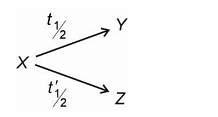A radioactive nuclei X decays simultaneously to two nuclei Y and Z as:

t½ is 12 minutes while t'½ is 3 minutes. Find the time in which nuclei X decays 50%.

t½ is 12 minutes while t'½ is 3 minutes. Find the time in which nuclei X decays 50%.
4.8 minutes
15 minutes
2.4 minutes
9 minutes
The Correct Option is C
Solution and Explanation
The correct answer is 2.4 minutes
Top Questions on Radioactivity
- The half-life of a radioactive substance is 4 hours. If initially there are 256 grams, how much remains after 10 hours?
- BITSAT - 2025
- Physics
- Radioactivity
- Write two properties of beta rays.
- Bihar Board XII - 2025
- Physics
- Radioactivity
- The half-life of a radioactive element is 10 minutes. Find the time in which its activity reduces to 1/16 of the original.
- The half life of a radioactive substance is 10 minutes. If $n_1$ and $n_2$ are the number of atoms decayed in 20 and 30 minutes respectively, then $n_1 : n_2 = $
- AP EAPCET - 2025
- Physics
- Radioactivity
- Given: \[ \frac{197}{96} X \to \frac{197}{95} Y + Z + V \quad \text{what is Z?} \]
- KEAM - 2025
- Physics
- Radioactivity
Questions Asked in JEE Main exam
- The value of \( (\sin 70^\circ)(\cot 10^\circ \cot 70^\circ - 1) \) is:
- JEE Main - 2025
- Trigonometric Identities
- Ice at \( -5^\circ C \) is heated to become vapor with temperature of \( 110^\circ C \) at atmospheric pressure. The entropy change associated with this process can be obtained from:
- JEE Main - 2025
- Thermodynamics
- Let C be the circle of minimum area enclosing the ellipse E: \( \frac{x^2}{a^2} + \frac{y^2}{b^2} = 1 \) with eccentricity \( \frac{1}{2} \) and foci \( (\pm 2, 0) \). Let PQR be a variable triangle, whose vertex P is on the circle C and the side QR of length 29 is parallel to the major axis and contains the point of intersection of E with the negative y-axis. Then the maximum area of the triangle PQR is:
- JEE Main - 2025
- Coordinate Geometry
- Let circle $C$ be the image of
$$ x^2 + y^2 - 2x + 4y - 4 = 0 $$
in the line
$$ 2x - 3y + 5 = 0 $$
and $A$ be the point on $C$ such that $OA$ is parallel to the x-axis and $A$ lies on the right-hand side of the centre $O$ of $C$.
If $B(\alpha, \beta)$, with $\beta < 4$, lies on $C$ such that the length of the arc $AB$ is $\frac{1}{6}$ of the perimeter of $C$, then $\beta - \sqrt{3}\alpha$ is equal to: 0.01 mole of an organic compound (X) containing 10% hydrogen, on complete combustion, produced 0.9 g H₂O. Molar mass of (X) is ___________g mol\(^{-1}\).
- JEE Main - 2025
- Organic Chemistry
Concepts Used:
Radioactivity
Radioactivity is a phenomenon observed in certain elements where unstable atomic nuclei spontaneously emit energy and subatomic particles. This process is driven by the desire of the nucleus to achieve a more stable state. It's crucial to understand the three main types of radioactive decay:
Alpha Decay: In alpha decay, a nucleus emits an alpha particle, consisting of two protons and two neutrons.
Beta Decay: Beta decay involves the emission of a beta particle, which can be a positron or an electron, from an unstable nucleus.
Gamma Decay: Gamma decay releases gamma rays, electromagnetic radiation, to achieve a more stable nuclear state.
The emission of these particles and energy is a result of nuclear instability. The rate of decay is characterized by the half-life, the time taken for half of the radioactive material to undergo decay. Radioactivity has diverse applications, from medical treatments and industrial processes to power generation in nuclear reactors.